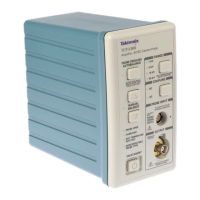TCP303 and TCP404XL Performance Verification
Procedure
1. Do not clamp the
current probe around any conductor, but make sure the
jaws are locked shut.
2. Press the ampl
ifier PROBE DEGAUSS AUTOBALANCE button. Wait for
the degauss/autobalance routine to complete before proceeding. The routine
is complete when the indicator light turns green.
3. Clamp the current probe around the 50 turn current loop, as shown. (See
Figure 10 on page 33.) Maintain proper polarity; the arrow-shaped indicator
on the probe points away from the (+) terminal of the current source.
4. For each of the amplifier range settings, perform the following steps: (See
Table19onpage35.)
a. If you are testing a TCP303, set the amplifier range to the first setting for
that probe. (See Table 19 on page 35.) For example, set the range to 5A/V.
b. Set the current source output to the first positive (+) setting for the probe
you are testing. (See Table 19 o n page 35.) For example, if you are testing
a TCP303, set the output to +0.100 A. (Each output level is tested at both
polarities; later in the procedure, you will set the output to -0.100 A.)
c. Enable the output of the current source.
d. Record the exact measurement of the digital multimeter as M1.
e. Set the current source ou tput to the first negative (-) setting for the probe
you are testing. (See Table 19 o n page 35.) For example, if you are testing
a TCP303, set the output to -0.100 A.
f. Record the exact measurement of the digital multimeter as M2.
g. Verify that the measured output (M1-M2) is within the warranted
specification by computing %Error as follows:
For example, you may measure values of 0.990V for M1 and -0.998V for M2.
With an expected V
E
of 1.0 V, you compute the %Error as follows:
34 TCPA300/400 Amplifiers and TCP300/400 Series Current Probes Service Manual

